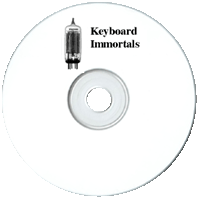

Audiophile and electronics pioneer Joseph Tushinsky had a refurbished Vorsetzer in his home and over the years collected some 2,800 Welte piano rolls and created this radio show in his living room.

10 old time radio show recordings
(total playtime 9 hours, 16 min)
available in the following formats:
1 MP3 CD
or
10 Audio CDs
Text on OTRCAT.com ©2001-2025 OTRCAT INC All Rights Reserved. Reproduction is prohibited.

Johann Sebastian Bach and Wolfgang Amadeus Mozart adopted the piano and used them to compose many of their most important works. The Industrial Revolution brought not only mass production of pianos and high-quality piano wire but introduced the cast iron frames which allowed for instruments with a seven-octave range (opposed to the five-octave pianos of Mozart's time). These were the pianos used by Haydn, Beethoven, Chopin, and Liszt. Although the modern piano was relatively easy to play, mastering the instrument could take a lifetime.

Around 1902, German acoustician Dr. Edwin Welte developed a more accurate note recording system by making greater use of electrical sensors, carbon contacts, and mercury conductors. The Welte Vorsetzer captured everything the pianist did to the instrument during a performance, and classical musicians flocked to have their performances recorded by the device.
In a traditional player piano, the paper roll mechanism is built into the piano. The Vorsetzer (literally "sitter in front") was a device which was rolled up to the keyboard of a grand piano. The device had a felt covered wooden arm or finger for each note on the piano, and the music played was considered a faithful reproduction of the original performance. This is the basis for the syndicated program Keyboard Immortals Play Again in Stereo.

The hour-long Keyboard Immortals Play Again in Stereo began broadcasting on KFAC Los Angeles and expanded to stations in 50 cities in 1968.
Text on OTRCAT.com ©2001-2025 OTRCAT INC All Rights Reserved. Reproduction is prohibited.
You have reached the maximum number of votes for a unregistered user.
Please login or create a new account to continue...
You have reached the maximum number to down votes in this page.



Keyboard Immortals Disc A001
|
Add Audio CD to Cart - $5.00 |
Keyboard Immortals Disc A002
|
Add Audio CD to Cart - $5.00 |
Keyboard Immortals Disc A003
|
Add Audio CD to Cart - $5.00 |
Keyboard Immortals Disc A004
|
Add Audio CD to Cart - $5.00 |
Keyboard Immortals Disc A005
|
Add Audio CD to Cart - $5.00 |
Keyboard Immortals Disc A006
|
Add Audio CD to Cart - $5.00 |
Keyboard Immortals Disc A007
|
Add Audio CD to Cart - $5.00 |
Keyboard Immortals Disc A008
|
Add Audio CD to Cart - $5.00 |
Keyboard Immortals Disc A009
|
Add Audio CD to Cart - $5.00 |
Keyboard Immortals Disc A010
|
Add Audio CD to Cart - $5.00 |
Please wait...
COMMENTS
Be the first to comment on "Keyboard Immortals"
Leave a comment